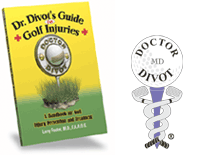Golf injuries occur with surprising frequency to both the professional and the amateur golfer. What you read here should quell the notion that golf is a cushy "gentleman’s" pastime.
The vast majority of golf injuries are not the result of single traumatic or freak accidents. Rather, they occur as a result of tissue damage sustained over time from overuse and poor technique. Most golf injuries fall into the general categories of strains, sprains, fractures, and tendonitis.
 |  |
A muscle strain is a partial tearing or stretching injury to a muscle. If muscle fibers are overstretched, especially when they are vigorously contracting, they can tear. A muscle strain usually results in immediate and severe pain, and the involved muscle will become tender to touch, swollen, black-and-blue (bruised), and painful to use.
A sprain is a stretching or tearing injury to a ligament (a specialized tissue that connects bone to bone and stabilizes joints). Sprain injuries can be graded based on how severely the ligament tissue is damaged. Sprain injuries are characterized by pain, swelling, tenderness, and limited joint motion.
A fracture (break) is a failure of bone tissue. Excessive compression, twisting (torsion), or bending forces causes bones to fracture. A stress fracture occurs when bone is injured by repeated small stresses (micro-trauma) rather than one big catastrophic crunch.
Tendonitis is one of the most common golf injuries, frequently affecting areas such as the elbow, shoulder, and wrist. Tendons are specialized tissues designed to connect muscles to bones. The most common mechanism of tendon injury in golf—and in life—involves simply pulling too hard on the tendon. With repeated stress, tendons sustain microscopic tears. Tendonitis, then, is a reflection of tendon injury and of the body’s often slow healing process for tendons. It is characterized by localized swelling, tenderness to touch, and pain when the injured tendon is stressed.
“Every golfer understands the importance of course management in relation to performance. But how much do you know about ‘body management’—that is, taking care of your body to prevent injury or recover from it? Dr. Larry Foster’s book, Dr. Divot’s Guide to Golf Injuries, should be your personal coach in this important area.” Gary Wiren, Ph.D., PGA Master Professional "Dr. Divot's Guide to Golf Injuries...should be read by every serious golfer or instructor or anyone hoping to remain one...[it]..is not only educational, but beneficial to your health." GolfTodayMagazine.com Click here to learn more about the book (table of contents, excerpts, ordering info...)
|























